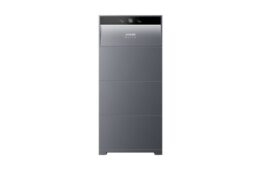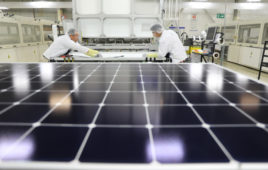Solar contractors working in expanding regions along the East Coast have the unique challenge of installing PV arrays that can withstand upwards of 100-mph winds. Every June to November, those coastal states, especially Florida, are susceptible to the annual superstorms as they travel northwest from the Caribbean.

Goldin Solar
When the entire solar array is assembled, it acts as a single unit, but each component must meet certain wind pressure load ratings to be installed in these environments. The main concern on an array is wind uplift on panels, as they have the largest surface area on the system. However, making smart roof penetrations, not skimping on rail attachments and selecting appropriate mounting and racking solutions can keep arrays in place through high-velocity hurricane wind zone areas.
Mounting for hurricanes and high winds
The pressure ratings considered when analyzing sites for construction are downward or negative pressure (snow) and uplift or suction (wind). Wind loads will vary by location and physical landscape. Being near the coast could mean stronger winds, while wind could be minimized in heavily wooded or residential areas.
When mounting a rooftop solar system suitable for hurricane conditions, installers should first consider the roof itself. On composition shingle rooftops, solar arrays should attach to the rafters instead of the decking. Miami PV contractor Goldin Solar uses an L-bracket that has space for two lag bolts instead of one when making roof attachments.
“The solar system is like a chain, where the top of the chain is the glass,” said Daren Goldin, CEO of Goldin Solar. “That’s the large surface area exposed to the elements, and the bottom of the chain on the other end is the threads of the lag bolts, embedded into the wooden rafter because you have to make sure that from one side of the chain to the other side, all the components meet the needs of building codes and conditions.”
Rail-less systems aren’t recommended for comp shingle rooftops in hurricane zones, but they are viable on standing-seam metal roofs since the seam itself can act as a rail. In standing seam installation, there are zero penetrations, with bolts instead locking in place through indentations in the seam.
Ballasted rooftop systems installed with lower wind conditions don’t require penetrations, but in hurricane zones, they could need a combination of ballast and mechanically fastened attachments.
“You don’t really see solar arrays ripping off of a roof unless the installer didn’t do something right,” said Barry Huseby, senior applications manager with mounting manufacturer SnapNrack.
The highest potential for wind uplift happens along a roof’s edge. Huseby recommended avoiding installing an array in that critical area of a roof, but in case it does happen, the spacing between attachments should be reduced to compensate for the additional uplift. Another precaution installers have used with SnapNrack products in hurricane zones is attaching each panel row to three rails instead of two. Resources like the American Society of Civil Engineers’ 2016 update on wind testing (ASCE 7-16) can help determine preferable system placement.
 Moss Solar, a Wimauma, Florida-based construction company specializing in utility-scale ground-mount solar, has experienced hurricane-related damage to PV systems, but it was never a result of the mounts specifically. Instead, it was caused by manufacturing failures at module frame connections.
Moss Solar, a Wimauma, Florida-based construction company specializing in utility-scale ground-mount solar, has experienced hurricane-related damage to PV systems, but it was never a result of the mounts specifically. Instead, it was caused by manufacturing failures at module frame connections.
“Wind speed is fundamental design criteria just as snow loads and seismic forces, and therefore must be considered on every project,” said Edwin Perkins, VP of Moss Solar. “However, mounting practices can vary significantly, with larger and more numerous fasteners, heavier structural members and closer pile spacings in wind-prone areas.”
Most of the company’s projects require custom engineering and manufacturing, and Moss selects UL-certified mounting and racking products that fit AHJ requirements.
“Moss Solar’s main area of operation can be heavily impacted by the effects of hurricanes. We are always concerned with the potential impacts of hurricane-force winds during construction,” Perkins said. “However, our team has developed detailed protocols to prepare for hurricanes. Executing these plans swiftly is necessary to protect our materials and equipment, but most importantly, to protect our neighbors and employees.”
Permitting and product approvals
Solar installers said Miami-Dade County is the authority on construction for hurricane zones. In the country’s most populated southern county, there are 36 different municipalities, each with its own building department and permitting requirements.
Depending on how prepared a project proposal is, permitting in Miami-Dade can take anywhere from one week to a couple months. A key component to quick permitting is using products that have been approved by the county for construction.
Notice of Approvals (NOA), or product approvals, have been present in Miami-Dade since the ’70s but had a resurgence following Hurricane Andrew in 1992.
“That really was a reset on how we regulated construction in South Florida, and really throughout the whole state,” said Edward Rojas, building official for the Miami-Dade County Building Department. “That whole product approval process became more regulated, more defined, and there’s not very many products that don’t go through that process, especially when it comes to the envelope and the exterior of the building.”
Solar racking and mounting are new to the product approval process, with Unirac receiving the first in June for its SOLARMOUNT PV mounting system. NOAs include pages of pictures and product design documents, detailing wind pressure ratings, framing loads, fastener resistance and installation instructions. Included are expiration dates and disclaimers that if approved equipment fails, the NOA can be revoked.
SnapNrack’s products have a high enough demand in the region that the company is working through the product approval process as well. The county issues NOAs for products with manufacturing ratings that have been verified by third party entities like UL. It’s a back-and-forth between the product’s engineer and the county, providing that backing data and component schematics.
“Our goal as a manufacturer is to make it as easy as we can for our installers,” Huseby said. “If that means we jump through some hoops to get our stuff certified with a particular area so that we can make it easier for our installers to use our products confidently, then we’re all for that.”
Goldin Solar has each of its solar systems custom designed per project, which requires more individual inspection than just using NOA products. Having worked in the area since 2014, the company has familiarized itself with the needs of the many building departments in Miami-Dade County and beyond.
“We used to joke that we’re a permitting company with a construction branch,” Goldin said. “We spent so much of our mental energy on permitting.”
The company wants to lean less on the idea of an approved package of solar equipment and use its engineering expertise to design systems for the specific needs of a rooftop and wind zone. Goldin Solar takes the most stringent requirements from each building department and builds its solar systems around that.
“It really does make sense to put in the extra time and the extra effort to get it done right and to know the ins and outs of structural considerations,” Goldin said.




Isn’t there a certain type of solar panel designed for a south-facing roof in a high-wind zone? I know I’ve seen them somewhere. The outside edge has an angled attachment. Please advise. Thank you, Wayne Vold.
You may be thinking of skirts attached to the bottom row of panels. All solar panels typically have the same wind certification. But then you need to find the appropriate mounting system for it.
I live in a “Special Wind Region” (Reno/Washoe County), with V=130 mph. 60-70mph winds are common (monthly), which can rattle/weaken/loosen connections. How do I find out if my future 40″x72″solar panels will need any extra attachments or reinforcement for these higher than normal wind loads? Their Spec Sheets mention how the panels themselves can handle snow and wind loads and so many Pascals of Force (which seemed fine to me), but nothing about the required attachments for various extreme wind zones or conditions in certain parts of the country. My tract home has a long-span 2×4 truss 30 degree (7:12) roof, which are only solidly attached with some toenails on the ends, with slip-clips at the interior non-bearing walls to allow a gap and vertical movement (“bounce”).
My solar salesman (a gentleman who is more salesman than experienced contractor) tells me different things every time I talk to him, first saying they add more attachments (24″o.c. vs the std 48″ for up to 110 mph) and then when the Plans were drawn for 48″ oc, with no mention on them of my county’s Special Wind Region, and he is now saying the 48″ o.c. is all that is needed. The gals in the office are no help, either. I know the 5/16″ steel lag bolts are often stronger than the wood when it comes to aged 2×4’s, and if off-center in the 1-5/8″ wide rafter, or next to a mis-drilled hole or another bolt close by (<4 diam., or 1-1/4" for the lags), they greatly weaken the rafter due to the decreased cross-sectional area, or by splitting it on the grain if 2 or more lags (or nails) are in a row.
Having an Engineering background (now long forgotten) & once worked as a Framing Carpenter in my younger days and then a City Plan Checker before I retired, I know residential plans for minor alterations are often rushed through the City and things like this are often overlooked by the guys (usually ex-carpenters or tradesmen) reviewing them, since they figure the Specialty contractor knows what he is doing. Unfortunately, their inexperienced 'remote' draftsmen do not, and the office staff never double-checks the plans against a checklist (esp. for the HOA's ARC or any special local requirements) before sending them out. No one seems to care since Homeowners Insurance covers it when the house gets damaged by the wind. 🙁
Not wanting the new solar panels to lift my truss roof off or sail away to my neighbor's yard in the next major wind storm, how do I verify what is actually required for a proper attachment in a 130 mph Wind Zone?
[Specs: Sunpower A-series panels, flat tile roof, 1 story house at the edge of the Sierra mountains (=rough terrain above open desert)].